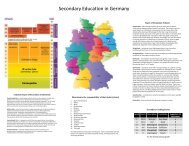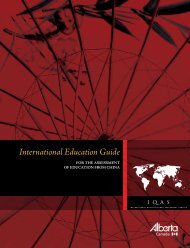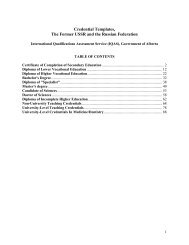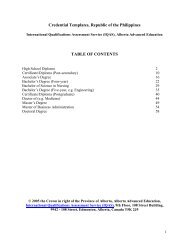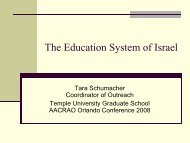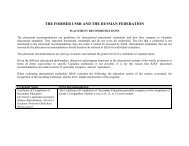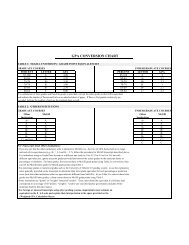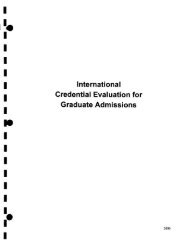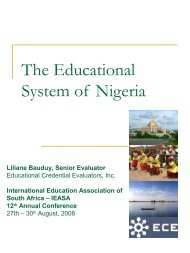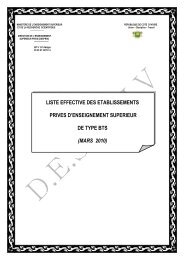NARIC guide on Higher Education Systems in the European Union
NARIC guide on Higher Education Systems in the European Union
NARIC guide on Higher Education Systems in the European Union
You also want an ePaper? Increase the reach of your titles
YUMPU automatically turns print PDFs into web optimized ePapers that Google loves.
I. <strong>Higher</strong> educati<strong>on</strong> system<br />
The educati<strong>on</strong> system <strong>in</strong> Sweden was previously str<strong>on</strong>gly centralised with nati<strong>on</strong>al educati<strong>on</strong> policy determ<strong>in</strong>ed by Parliament<br />
and implemented by <strong>the</strong> M<strong>in</strong>istry of Educati<strong>on</strong> and Science, with <strong>the</strong> assistance, until fairly recently, of <strong>the</strong> Nati<strong>on</strong>al Board of<br />
Educati<strong>on</strong> for schools and <strong>the</strong> Nati<strong>on</strong>al Board of Universities and Colleges for higher educati<strong>on</strong> (which were abolished <strong>in</strong><br />
1990 and 1992 respectively). These authorities had <strong>the</strong> resp<strong>on</strong>sibility for nati<strong>on</strong>al plann<strong>in</strong>g of educati<strong>on</strong> <strong>in</strong> cooperati<strong>on</strong> with<br />
representatives of <strong>the</strong> respective systems of educati<strong>on</strong>, which meant that educati<strong>on</strong> was <strong>the</strong> same all over <strong>the</strong> country. There<br />
were few private <strong>in</strong>stituti<strong>on</strong>s. Educati<strong>on</strong> was open to all categories of people, free of charge and with favourable State study<br />
assistance. In 1977, a far-reach<strong>in</strong>g reform of <strong>the</strong> higher educati<strong>on</strong> system took place with <strong>the</strong> creati<strong>on</strong> of an <strong>in</strong>tegrated and<br />
uniform system for all types of tertiary educati<strong>on</strong>, broadened admissi<strong>on</strong> policies for higher educati<strong>on</strong>, widened geographic<br />
distributi<strong>on</strong> of higher educati<strong>on</strong> and <strong>the</strong> creati<strong>on</strong> of recurrent educati<strong>on</strong>al opportunities. New measures to streng<strong>the</strong>n l<strong>in</strong>ks<br />
between higher educati<strong>on</strong> and research and to create closer ties between educati<strong>on</strong> and o<strong>the</strong>r areas of society were taken. In<br />
1979, Sweden <strong>in</strong>troduced a numerus clausus for higher educati<strong>on</strong>, which has made admissi<strong>on</strong> to most study programmes<br />
highly selective. In <strong>the</strong> 1990s educati<strong>on</strong> at all levels became more decentralised. A new reform of both upper-sec<strong>on</strong>dary<br />
school and higher educati<strong>on</strong> was launched <strong>in</strong> 1993, with for example, prol<strong>on</strong>gati<strong>on</strong> of vocati<strong>on</strong>al upper-sec<strong>on</strong>dary school to<br />
three years <strong>in</strong>stead of two, fewer prescribed programmes <strong>in</strong> both sec<strong>on</strong>dary school and higher educati<strong>on</strong>, a new degree system<br />
<strong>in</strong> higher educati<strong>on</strong>, etc.<br />
The 1977 reform <strong>in</strong>troduced <strong>the</strong> högskola, <strong>the</strong> Swedish collective name for higher educati<strong>on</strong>, encompass<strong>in</strong>g not <strong>on</strong>ly<br />
traditi<strong>on</strong>al university studies but also those at <strong>the</strong> various professi<strong>on</strong>al <strong>in</strong>stitutes and university colleges and a number of<br />
programmes previously taught <strong>in</strong> o<strong>the</strong>r parts of <strong>the</strong> higher educati<strong>on</strong> system. Most of <strong>the</strong> programmes <strong>in</strong>cluded <strong>in</strong> <strong>the</strong><br />
broadened def<strong>in</strong>iti<strong>on</strong> of higher educati<strong>on</strong> are under <strong>the</strong> jurisdicti<strong>on</strong> of <strong>the</strong> M<strong>in</strong>istry of Educati<strong>on</strong> and Science, o<strong>the</strong>rs are under<br />
<strong>the</strong> M<strong>in</strong>istry of Agriculture and paramedical programmes are under <strong>the</strong> county councils. Research is <strong>in</strong>tegrated with and<br />
founded <strong>on</strong> close local cooperati<strong>on</strong> with <strong>the</strong> undergraduate and postgraduate programmes of <strong>the</strong> university or <strong>in</strong>stitute<br />
c<strong>on</strong>cerned. This applies both to basic research at higher educati<strong>on</strong> <strong>in</strong>stituti<strong>on</strong>s and to what is known as sectoral (i.e. externally<br />
funded) research.<br />
In <strong>the</strong> 1993 reform of higher educati<strong>on</strong>, higher educati<strong>on</strong> <strong>in</strong>stituti<strong>on</strong>s were given <strong>in</strong>creased aut<strong>on</strong>omy <strong>in</strong> <strong>the</strong> organisati<strong>on</strong> of<br />
studies, admissi<strong>on</strong>s, use of resources and general organisati<strong>on</strong>. The new degree system provides greater freedom for <strong>the</strong><br />
students to plan <strong>the</strong>ir own studies. Diversity and competiti<strong>on</strong> between higher educati<strong>on</strong> <strong>in</strong>stituti<strong>on</strong>s were <strong>in</strong>troduced toge<strong>the</strong>r<br />
with <strong>in</strong>centives for improved quality. First <strong>the</strong> Chancellor’s office, later <strong>the</strong> Department of Evaluati<strong>on</strong> and Quality Audit<br />
with<strong>in</strong> <strong>the</strong> Nati<strong>on</strong>al Agency for <strong>Higher</strong> Educati<strong>on</strong>, obta<strong>in</strong>ed nati<strong>on</strong>al resp<strong>on</strong>sibility for quality development and assessment.<br />
The Nati<strong>on</strong>al Agency for <strong>Higher</strong> Educati<strong>on</strong> also has <strong>the</strong> task of decid<strong>in</strong>g about accreditati<strong>on</strong> of academic degrees and <strong>the</strong> right<br />
of certa<strong>in</strong> university colleges to establish professorships. Independent universities and university colleges are recognised by<br />
<strong>the</strong> government and may obta<strong>in</strong> <strong>the</strong> right to award degrees and/or receive State subsidies and for <strong>the</strong>ir students to receive study<br />
assistance. Diplomas from all k<strong>in</strong>ds of higher educati<strong>on</strong> <strong>in</strong>stituti<strong>on</strong>s recognised by <strong>the</strong> government have equal official value.<br />
I.1. The <strong>in</strong>stituti<strong>on</strong>s of higher educati<strong>on</strong><br />
There are at present six multi-faculty universities and <strong>on</strong>e agricultural university <strong>in</strong> Sweden. These universities, toge<strong>the</strong>r with<br />
<strong>the</strong> universities/<strong>in</strong>stitutes of technology and medic<strong>in</strong>e, have a permanent allocati<strong>on</strong> for research and postgraduate educati<strong>on</strong>.<br />
The more than 30 university colleges have research l<strong>in</strong>ks with <strong>the</strong> universities through special government grants. In additi<strong>on</strong><br />
to <strong>the</strong> State-run <strong>in</strong>stituti<strong>on</strong>s of higher educati<strong>on</strong>, <strong>the</strong>re are <strong>the</strong> semi-private Stockholm School of Ec<strong>on</strong>omics, Chalmers<br />
University of Technology and <strong>the</strong> University College of Jönköp<strong>in</strong>g. There are also local government-run colleges of health<br />
sciences for paramedical professi<strong>on</strong>s <strong>in</strong> all <strong>the</strong> six university regi<strong>on</strong>s (Stockholm, Uppsala, L<strong>in</strong>köp<strong>in</strong>g, Lund, Göteborg,<br />
Umeå), some of which, however, are merg<strong>in</strong>g with State-run <strong>in</strong>stituti<strong>on</strong>s.



